Uniaxial Tensile Behavior of Carbon Textile Reinforced Mortar
Abstract
:1. Introduction
2. Materials and Methods
2.1. Materials
2.1.1. Carbon Textile
2.1.2. Short Steel Fibers
2.1.3. High-Performed Fine-Grained Mortar
2.2. Experimental Program
2.2.1. Testing Series
2.2.2. Tensioning System
- Firstly, the two free ends of the carbon textiles, which are not impregnated with the epoxy resin within the range of around 80 mm, are anchored at either end of the device using the self-locking principle (see Figure 2). During the process, the roller beneath the chute slides to adjust the position of the chute. Note that warp fibers in the upper and lower layers (when there are two textile layers) must be strictly aligned and parallel to the edge of the textile groove.
- Stretch the carbon textiles by tightening the nut at one end. Note that the loading process should be uniform and slow so that the fiber bundles are evenly and cooperatively stressed. The pre-tensioning force is measured by the load cell at the other end, output to the data acquisition system, and is finally displayed on the digital terminal.
- When the target pre-tension is reached, the loading is paused. After 5–10 minutes, the loss of pre-tension is measured and recorded. The pre-tension force is then re-applied to reach the target value. This operation calls additional tensioning, which should be repeated afterwards. To maintain a stable pre-tension level, the textile should stay stretched for 24 h, during which time additional tensioning should be implemented every 8 h; in other words, the additional tensioning is repeated three times in total.
- Finally, the mortar matrix is cast on the textile.
2.2.3. Preparation of the Composite Specimens
2.2.4. Uniaxial Tensile Test Setup
3. Results and Discussion
3.1. Influence of Reinforcement Ratio on the TRM Tensile Behavior
3.2. Effect of Steel Fibers
- As shown in Figure 16a, the steel fibers are evenly distributed throughout the cross-section of the specimen. Well-distributed steel fibers form a good bond with their surrounding matrix and further reduce the shrinkage of the matrix, thus reducing the resulting internal defects in the matrix. Moreover, steel fibers also inhibit the formation of micro-cracks, which develop because of shrinkage.
- Steel fibers play a bridge role in micro-cracks and delay the formation of the first macro-crack. Thus, higher stress is needed to cause the transition from micro-cracks to macro-crack. The bridging of steel fibers in micro-cracks contributes to the improved first-crack stress of TRM specimens with steel fibers. In addition, the bridging action of steel fibers in macro-cracks causes additional stress transfer over the cracks (Figure 16b,c); thus, a new crack can be formed at a smaller distance from an existing crack. Thus, fine multiple cracking can develop and lead to pronounced ductility.
- The elastic modulus of carbon textile is greater than that of mortar matrix, so their deformation after tensioning is different, causing a relative sliding trend to occur. For TRM composites without the addition of short fibers, the bond properties between the textile and the cementitious matrix depend on the friction and adhesive caused by the matrix hydration products. For TRM composites with the addition of steel fibers, the bonding properties are enhanced. Steel fibers inserted into the textile grids can mitigate the trend, enabling a better cooperation of the carbon textile and mortar. As shown in Figure 17, steel fibers there can resist shearing force. Hence, it can be summarized that steel fibers in the textile grids provide additional "shear resistant ability" between the carbon fabric and the mortar, thus improving the bonding properties between carbon fabric and inorganic mortar in CTRM. Investigation of the fracture surfaces of TRM with steel fibers using an optical microscope has helped to explain this new link (Figure 16d).
3.3. Effect of Prestress
4. Conclusions
Author Contributions
Funding
Acknowledgments
Conflicts of Interest
References
- Tran, M.T.; Vu, X.H.; Ferrier, E. Experimental and analytical analysis of the effect of fibre treatment on the thermomechanical behaviour of continuous carbon textile subjected to simultaneous elevated temperature and uniaxial tensile loadings. Constr. Build. Mater. 2018, 183, 32–45. [Google Scholar] [CrossRef]
- Schneider, K.; Lieboldt, M.; Liebscher, M.; Fröhlich, M.; Hempel, S.; Butler, M.; Schröfl, C.; Mechtcherine, V. Mineral-based coating of plasma-treated carbon fibre rovings for carbon concrete composites with enhanced mechanical performance. Materials 2017, 10, 360. [Google Scholar] [CrossRef] [PubMed]
- Mechtcherine, V. Novel cement-based composites for the strengthening and repair of concrete structures. Constr. Build. Mater. 2013, 41, 365–373. [Google Scholar] [CrossRef]
- Mechtcherine, V. Towards a durability framework for structural elements and structures made of or strengthened with high-performance fibre-reinforced composites. Constr. Build. Mater. 2012, 31, 94–104. [Google Scholar] [CrossRef]
- Butler, M.; Lieboldt, M.; Mechtcherine, V. Application of textile-reinforced concrete (TRC) for structural strengthening and in prefabrication. In Proceedings of the International Conference on Advanced Concrete Materials (ACM), Stellenbosch, South Africa, 2010; pp. 125–134. [Google Scholar]
- Papanicolaou, C.G. Applications of textile-reinforced concrete in the precast industry. In Textile Fibre Composites in Civil Engineering; Triantafillou, T., Ed.; Woodhead Publishing: Patras, Greece, 2016; pp. 227–244. ISBN 9781782424467. (online). [Google Scholar]
- Arundhathy, S.; Vasugi, V. Engineered cementitious composites for sustainable construction. Key Eng. Mater. 2016, 692, 17–26. [Google Scholar] [CrossRef]
- Zhang, R.; Matsumoto, K.; Hirata, T.; Ishizeki, Y.; Niwa, J. Application of PP-ECC in beam-column joint connections of rigid-framed railway bridges to reduce transverse reinforcements. Eng. Struct. 2015, 86, 146–156. [Google Scholar] [CrossRef]
- Qudah, S.; Maalej, M. Application of Engineered Cementitious Composites (ECC) in interior beam-column connections for enhanced seismic resistance. Eng. Struct. 2014, 69, 235–245. [Google Scholar] [CrossRef]
- Hegger, J.; Will, N.; Bruckermann, O.; Voss, S. Load-bearing behaviour and simulation of textile reinforced concrete. Mater. Struct. Constr. 2006, 39, 765–776. [Google Scholar] [CrossRef]
- Si Larbi, A.; Contamine, R.; Ferrier, E.; Hamelin, P. Shear strengthening of RC beams with textile reinforced concrete (TRC) plate. Constr. Build. Mater. 2010, 24, 1928–1936. [Google Scholar] [CrossRef]
- Hegger, J.; Horstmann, M.; Zell, M. Textile Reinforced Concrete–Realization in applications. Tailor Made Concr. Struct. 2008, 357–362. [Google Scholar]
- Raupach, M.; Cruz, C.M. Textile-reinforced concrete: Selected case studies. In Textile Fibre Composites in Civil Engineering; Triantafillou, T., Ed.; Woodhead Publishing: Patras, Greece, 2016; pp. 275–299. ISBN 9781782424467. [Google Scholar]
- Hegger, J.; Horstmann, M.; Feldmann, M.; Pyschny, D.; Raupach, M.; Büttner, T.; Feger, C. Sandwich panels made of TRC and discrete and continuous connectors. Int. RILEM Conf. Mater. Sci. 2010, I, 381–392. [Google Scholar]
- Williams Portal, N.; Zandi, K.; Malaga, K.; Wlasak, L. GFRP connectors in textile reinforced concrete sandwich elements. In Proceedings of the 19th IABSE Congress Stockholm, IABSE c/o ETH Hönggerberg, Sweden, 2016; pp. 1331–1338. [Google Scholar]
- Brückner, A.; Ortlepp, R.; Curbach, M. Textile reinforced concrete for strengthening in bending and shear. Mater. Struct. Constr. 2006, 39, 741–748. [Google Scholar] [CrossRef]
- Contamine, R.; Si Larbi, A.; Hamelin, P. Contribution to direct tensile testing of textile reinforced concrete (TRC) composites. Mater. Sci. Eng. A 2011, 528, 8589–8598. [Google Scholar] [CrossRef]
- Larrinaga, P.; Chastre, C.; Biscaia, H.C.; San-José, J.T. Experimental and numerical modeling of basalt textile reinforced mortar behavior under uniaxial tensile stress. Mater. Des. 2014, 55, 66–74. [Google Scholar] [CrossRef]
- Frank, J. Tragverhalten von Filamentgarnen in zementgebundener Matrix. Ph.D. Thesis, Technische Universitaet Dresden, Dresden, Germany, 2004. [Google Scholar]
- Barhum, R.; Mechtcherine, V. Effect of short, dispersed glass and carbon fibres on the behaviour of textile-reinforced concrete under tensile loading. Eng. Fract. Mech. 2012, 92, 56–71. [Google Scholar] [CrossRef]
- Contamine, R.; Junes, A.; Si Larbi, A. Tensile and in-plane shear behaviour of textile reinforced concrete: Analysis of a new multiscale reinforcement. Constr. Build. Mater. 2014, 51, 405–413. [Google Scholar] [CrossRef]
- Rambo, D.A.S.; de Andrade Silva, F.; Toledo Filho, R.D.; da Fonseca Martins Gomes, O. Effect of elevated temperatures on the mechanical behavior of basalt textile reinforced refractory concrete. Mater. Des. 2015, 65, 24–33. [Google Scholar] [CrossRef]
- Xu, S.; Krüger, M.; Reinhardt, H.-W.; Ožbolt, J. Bond Characteristics of Carbon, Alkali Resistant Glass, and Aramid Textiles in Mortar. J. Mater. Civ. Eng. 2004, 16, 356–364. [Google Scholar] [CrossRef]
- Dvorkin, D.; Poursaee, A.; Peled, A.; Weiss, W.J. Influence of bundle coating on the tensile behavior, bonding, cracking and fluid transport of fabric cement-based composites. Cem. Concr. Compos. 2013, 42, 9–19. [Google Scholar] [CrossRef]
- Colombo, I.G.; Magri, A.; Zani, G.; Colombo, M.; Di Prisco, M. Textile Reinforced Concrete: Experimental investigation on design parameters. Mater. Struct. Constr. 2013, 46, 1933–1951. [Google Scholar] [CrossRef]
- Reinhardt, H.W.; Krüger, M.; Große, C.U. Concrete Prestressed with Textile Fabric. J. Adv. Concr. Technol. 2003, 1, 231–239. [Google Scholar] [CrossRef] [Green Version]
- Barhum, R.; Mechtcherine, V. Influence of short dispersed and short integral glass fibres on the mechanical behaviour of textile-reinforced concrete. Mater. Struct. Constr. 2013, 46, 557–572. [Google Scholar] [CrossRef]
- Du, Y.; Zhang, X.; Zhou, F.; Zhu, D.; Zhang, M.; Pan, W. Flexural behavior of basalt textile-reinforced concrete. Constr. Build. Mater. 2018, 183, 7–21. [Google Scholar] [CrossRef]
- Ou, Y.; Zhu, D. Tensile behavior of glass fiber reinforced composite at different strain rates and temperatures. Constr. Build. Mater. 2015, 96, 648–656. [Google Scholar] [CrossRef]
- Zhu, D.; Peled, A.; Mobasher, B. Dynamic tensile testing of fabric-cement composites. Constr. Build. Mater. 2011, 25, 385–395. [Google Scholar] [CrossRef]
- Yan, L.; Kasal, B.; Huang, L. A review of recent research on the use of cellulosic fibres, their fibre fabric reinforced cementitious, geo-polymer and polymer composites in civil engineering. Compos. Part B Eng. 2016, 92, 94–132. [Google Scholar] [CrossRef]
- Tan, B.K.; Ching, Y.C.; Poh, S.C.; Abdullah, L.C.; Gan, S.N. A review of natural fiber reinforced poly(vinyl alcohol) based composites: Application and opportunity. Polymers 2015, 7, 2205–2222. [Google Scholar] [CrossRef]
- Kazim, A. Carbon fibers. In Fiber Technology for Fiber-Reinforced Composites; Seydibeyoğlu, M.Ö., Mohanty, A.K., Misra, M., Eds.; Woodhead Publishing: Patras, Greece, 2017; pp. 123–151. ISBN 9780081018712. [Google Scholar]
- Newcomb, B.A. Processing, structure, and properties of carbon fibers. Compos. Part A Appl. Sci. Manuf. 2016, 91, 262–282. [Google Scholar] [CrossRef]
- Du, Y.; Zhang, X.; Liu, L.; Zhou, F.; Zhu, D.; Pan, W. Flexural Behaviour of Carbon Textile-Reinforced Concrete with Prestress and Steel Fibres. Polymers 2018, 10, 98. [Google Scholar] [CrossRef]
- Donnini, J.; Corinaldesi, V.; Nanni, A. Mechanical properties of FRCM using carbon fabrics with different coating treatments. Compos. Part B Eng. 2016, 88, 220–228. [Google Scholar] [CrossRef]
- Yin, S.; Xu, S.; Li, H. Improved mechanical properties of textile reinforced concrete thin plate. J. Wuhan Univ. Technol. Mater. Sci. Ed. 2013, 28, 92–98. [Google Scholar] [CrossRef]
- Soe, K.T.; Zhang, Y.X.; Zhang, L.C. Material properties of a new hybrid fibre-reinforced engineered cementitious composite. Constr. Build. Mater. 2013, 43, 399–407. [Google Scholar] [CrossRef]
- Du, Y.; Zhang, M.; Zhou, F.; Zhu, D. Experimental study on basalt textile reinforced concrete under uniaxial tensile loading. Constr. Build. Mater. 2017, 138, 88–100. [Google Scholar] [CrossRef]


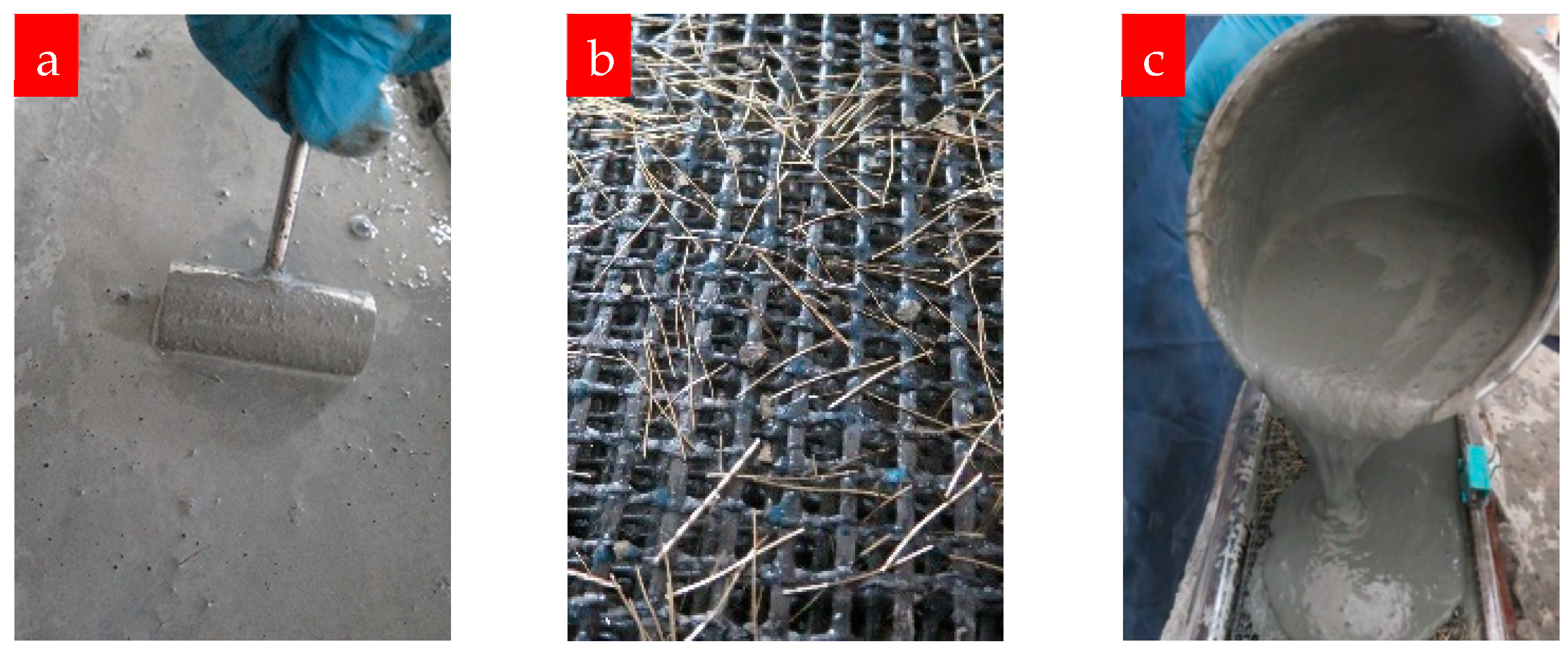
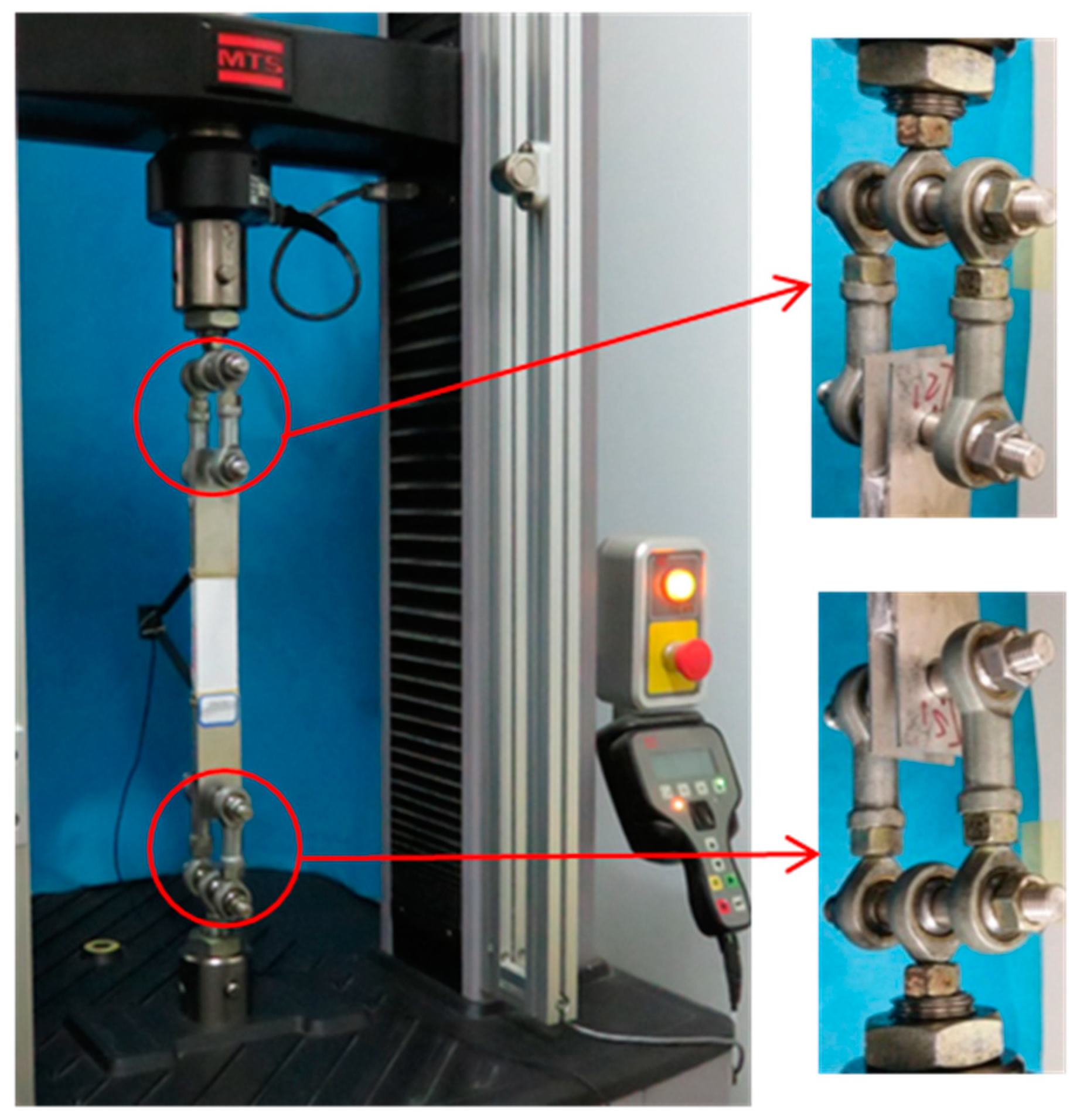


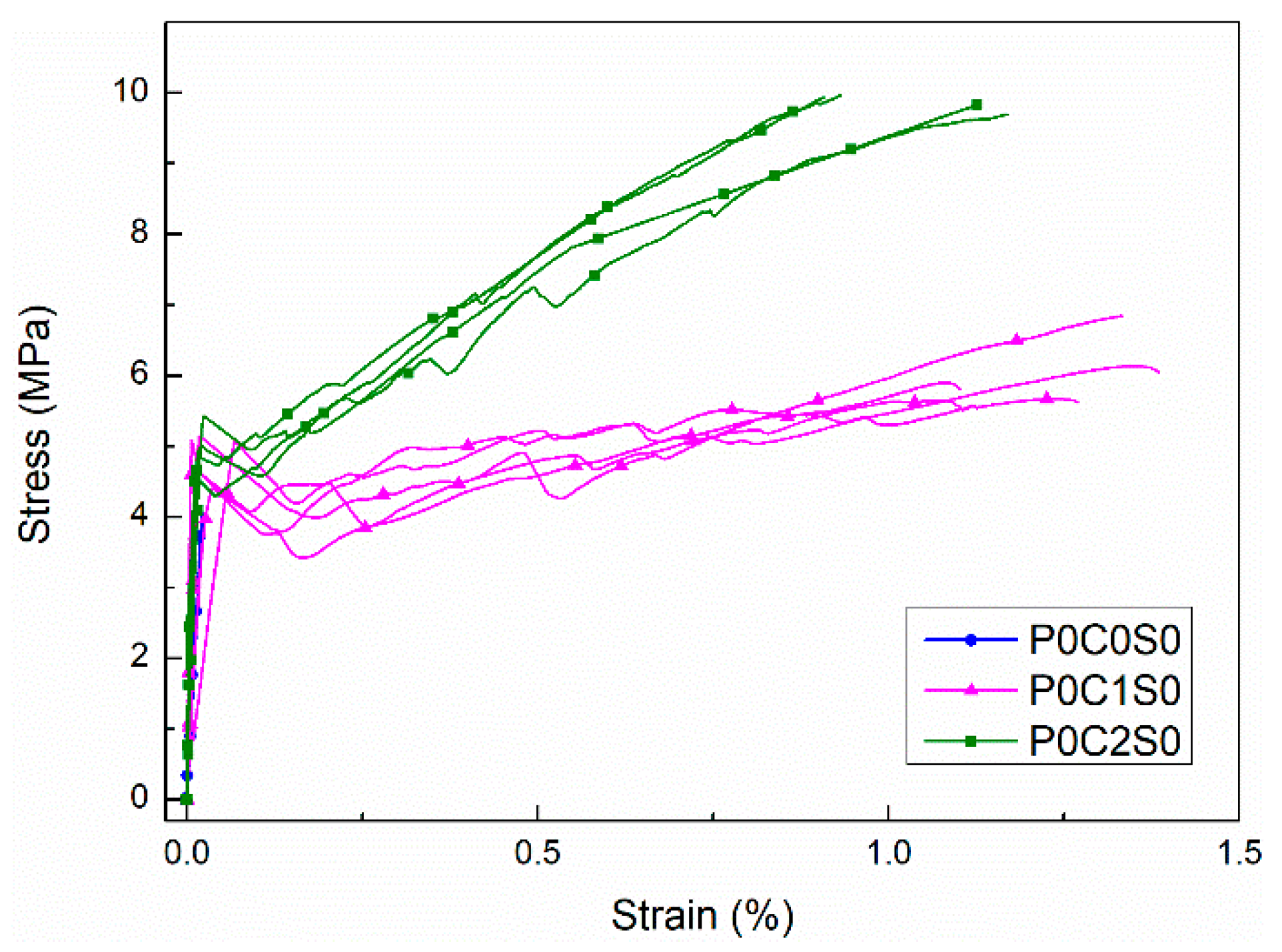

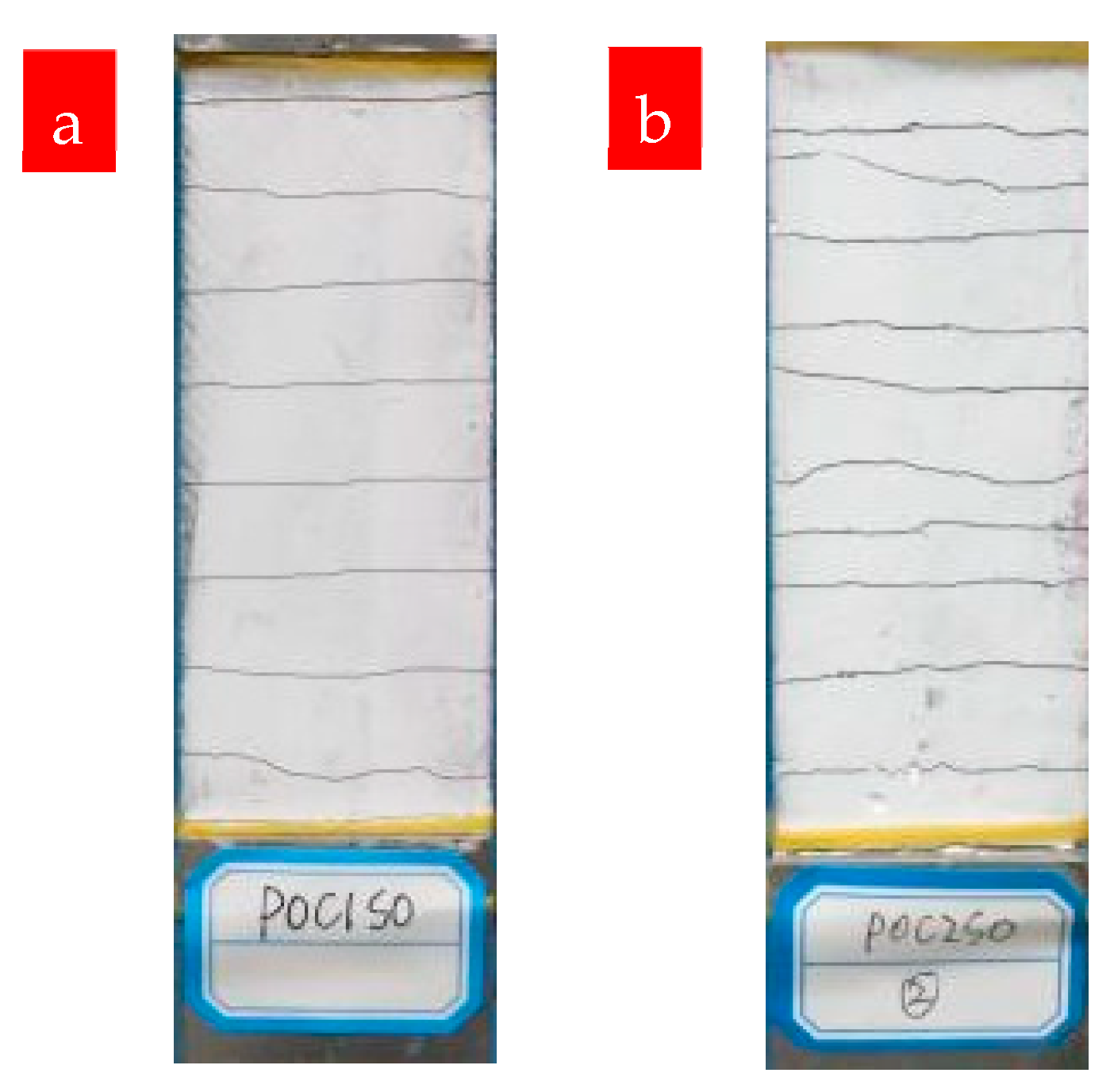
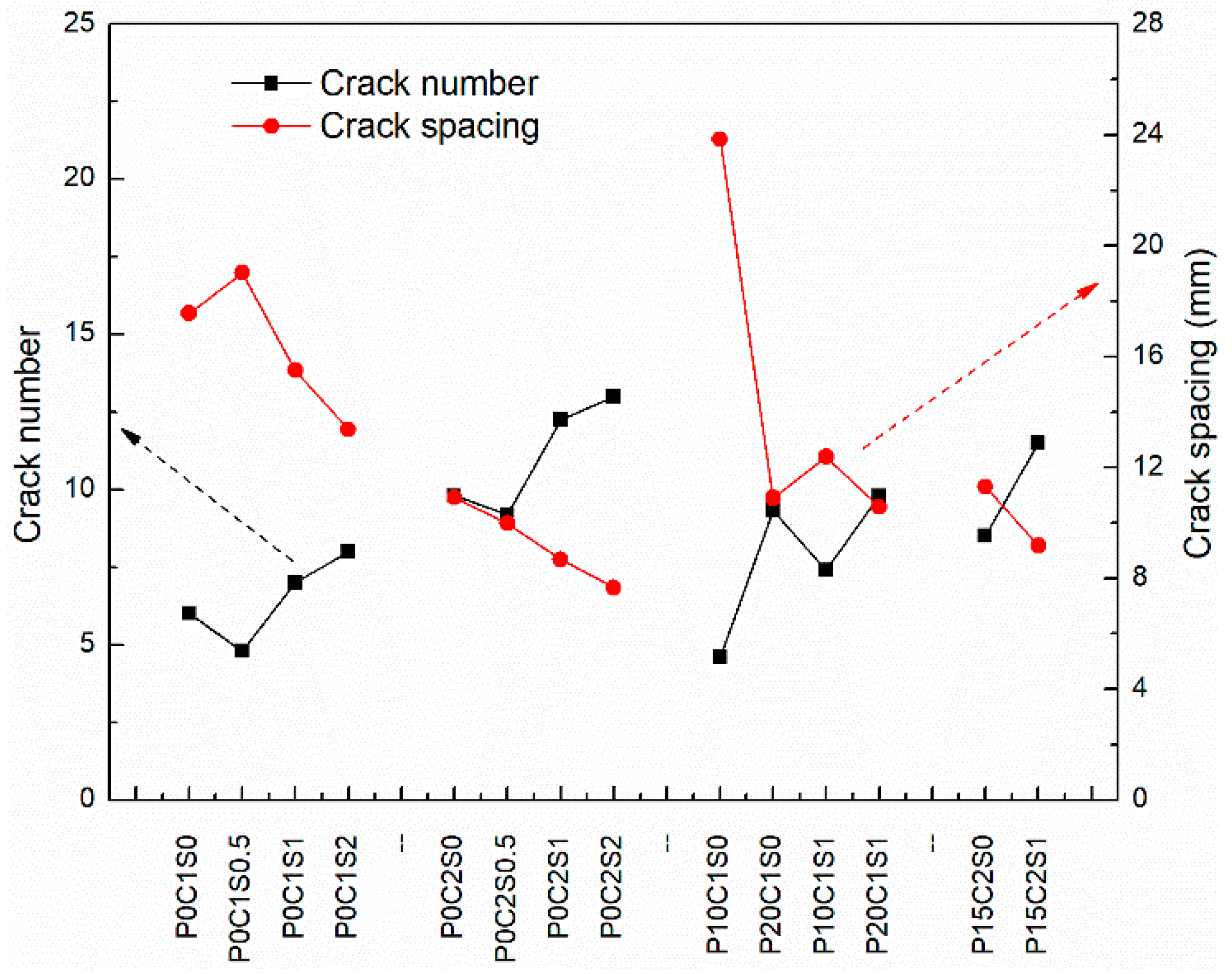

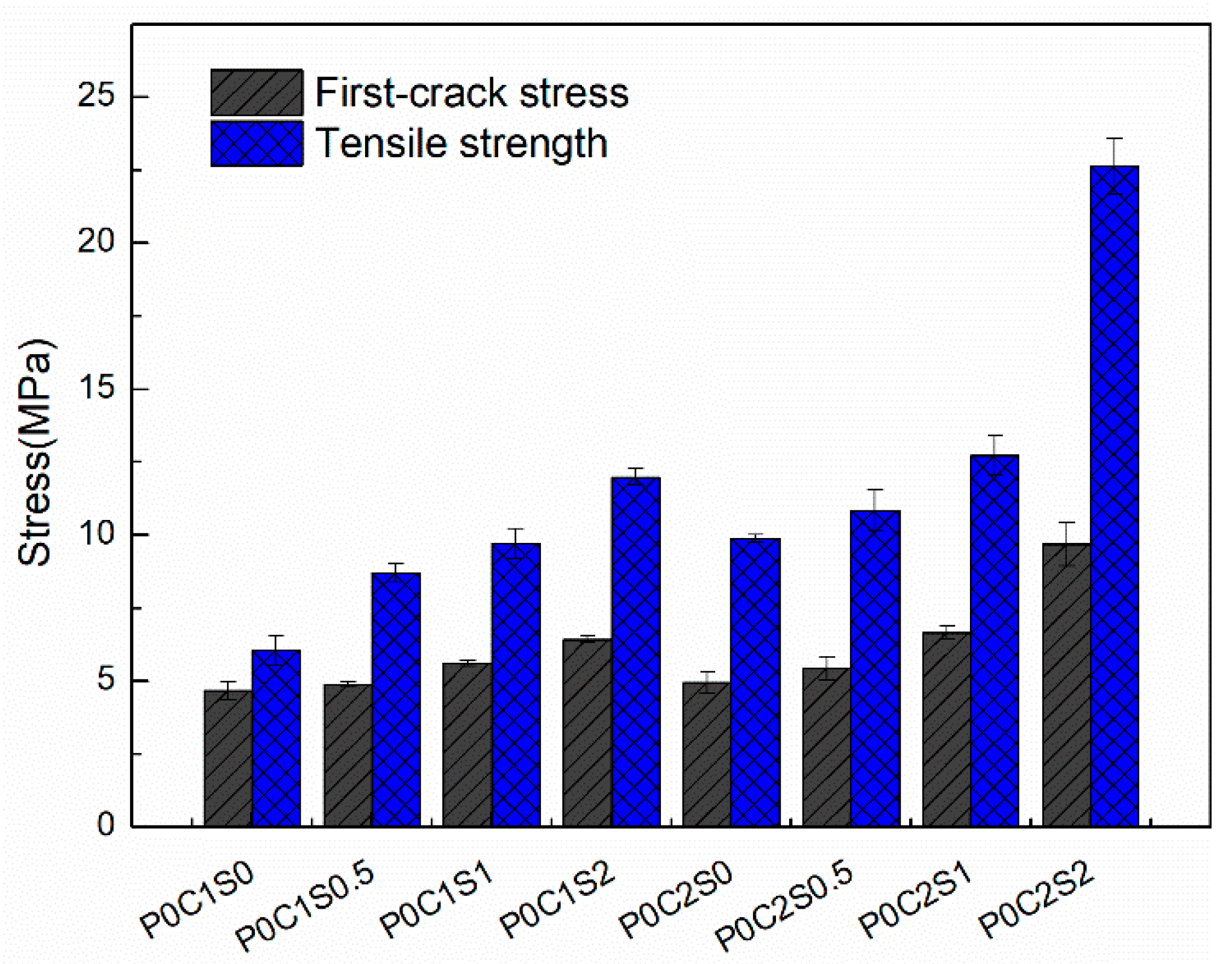
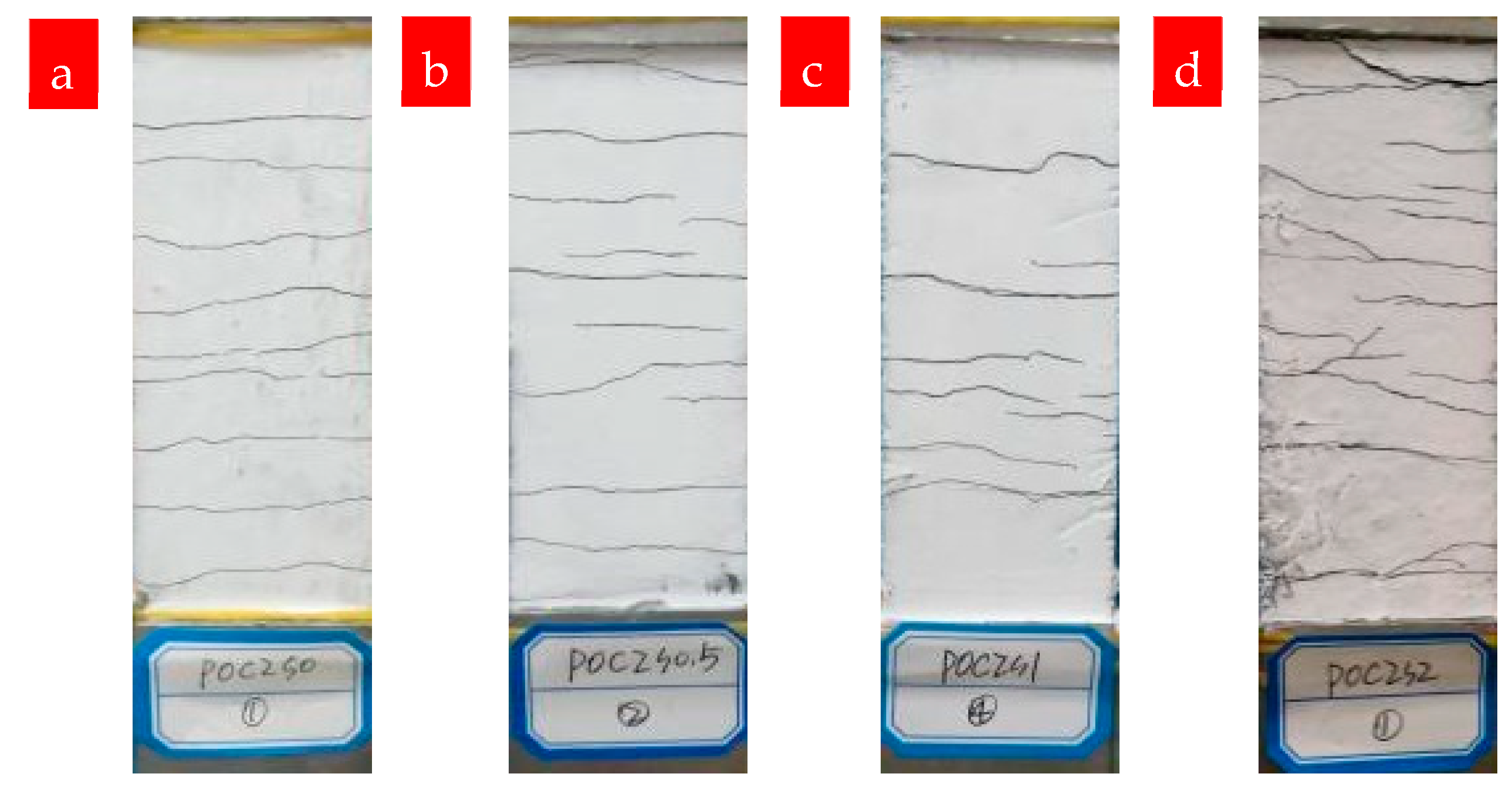



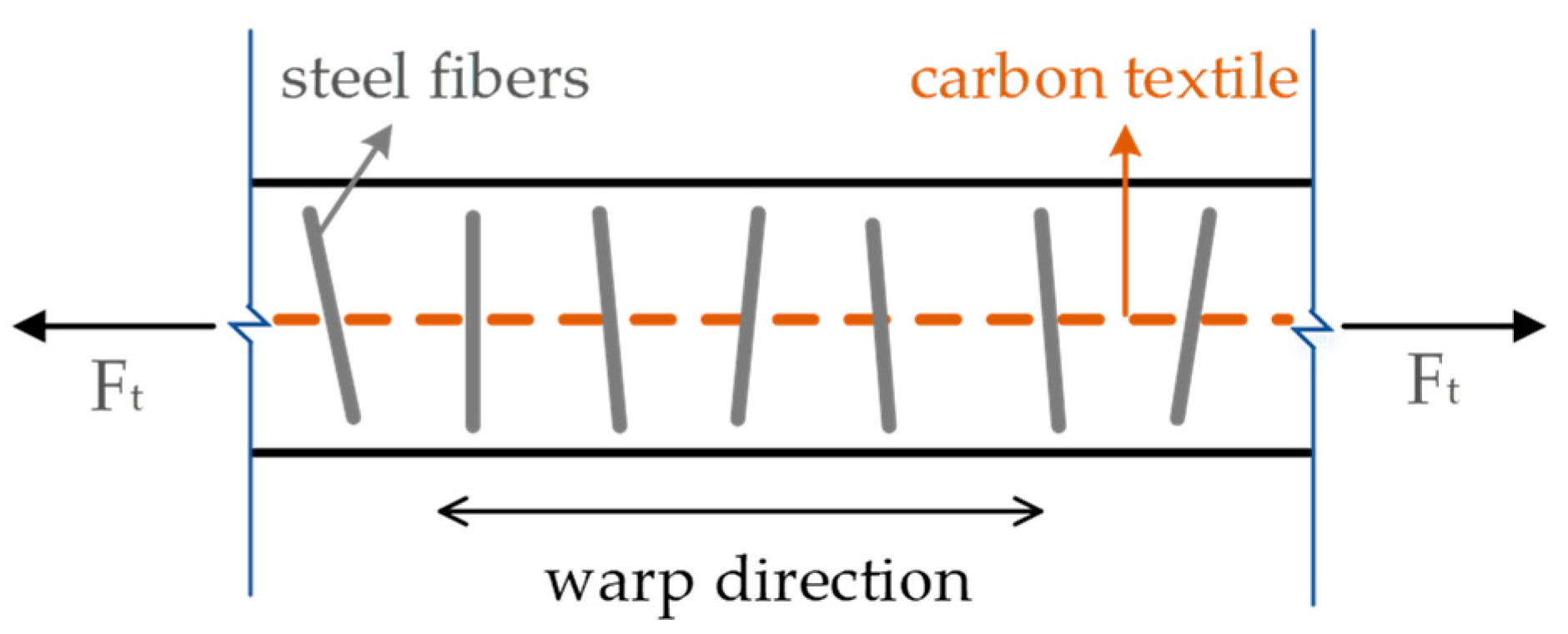



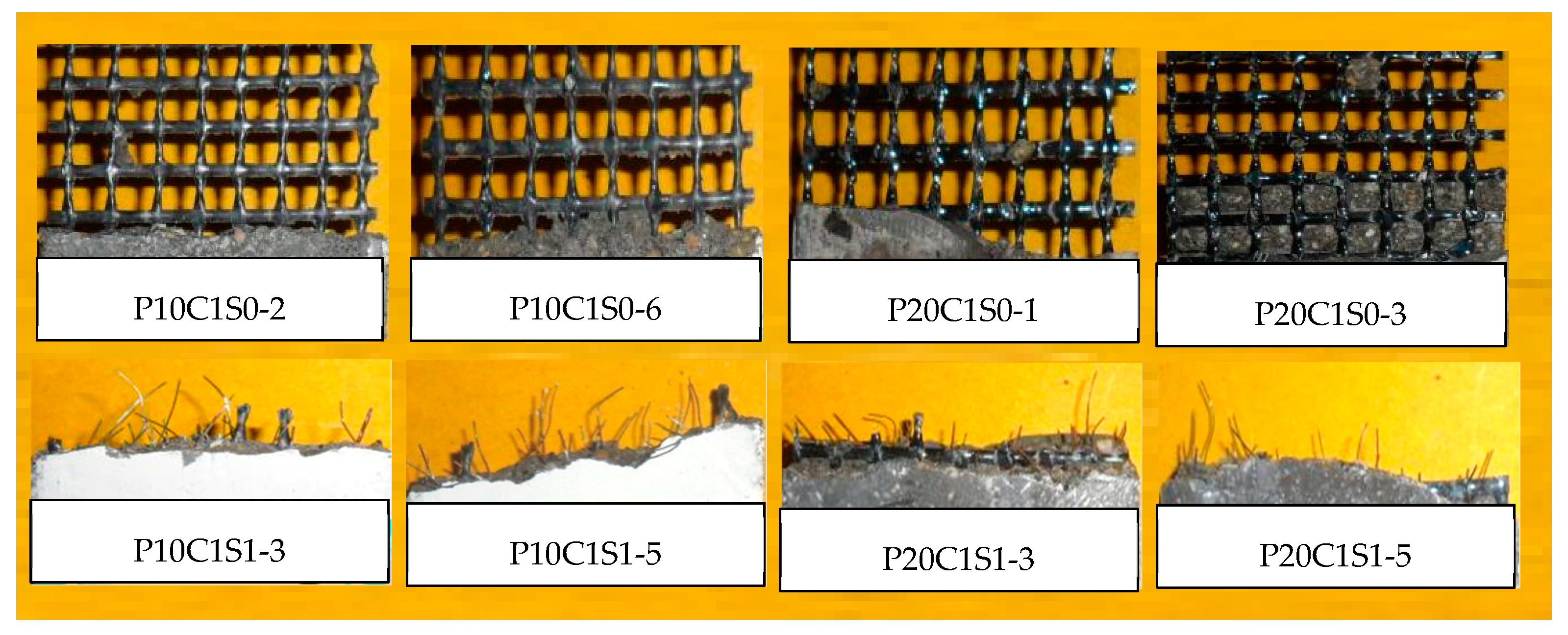
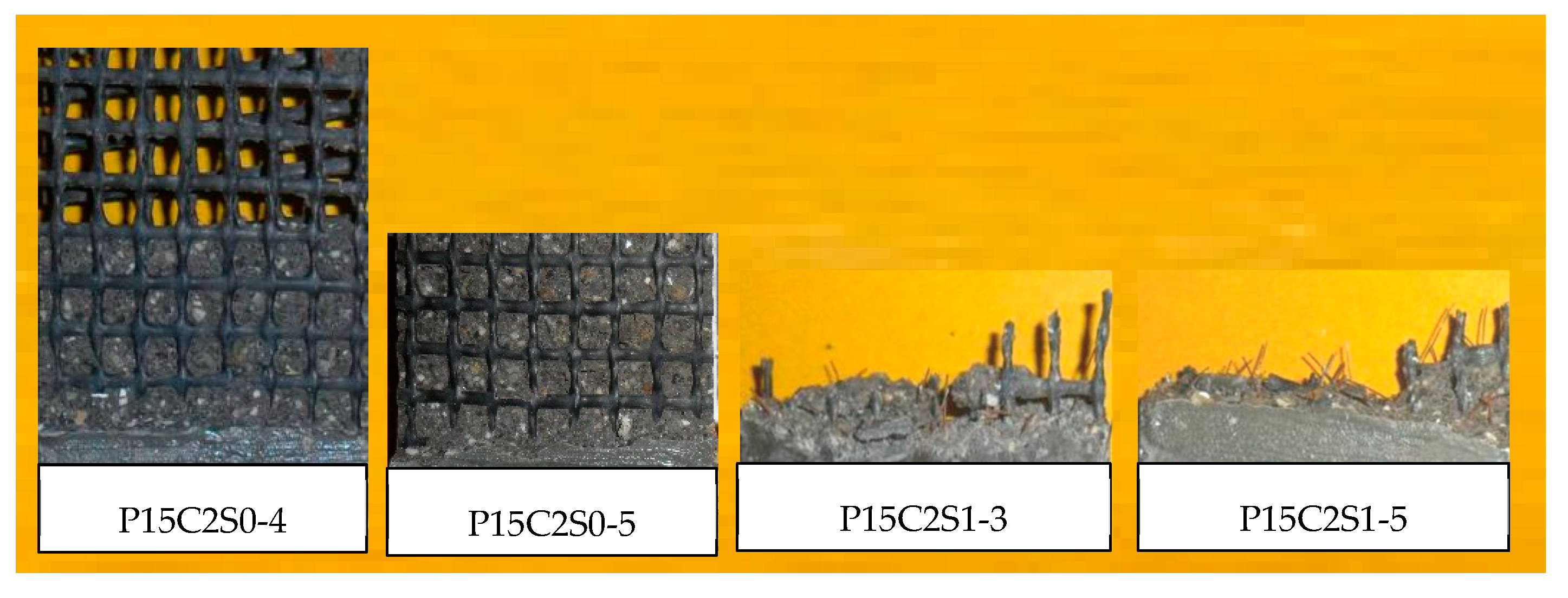
| Type | Tensile Strength (MPa) | Young’s Modulus (GPa) | Strain Capacity (%) | Density (g/cm3) | Cross-Sectional Area (mm2) | Tex (g/km) |
|---|---|---|---|---|---|---|
| 6K | 2290 | 230 | 1 | 1.8 | 0.218 | 390 |
| Diameter (mm) | Length (mm) | Density (g/cm3) | Tensile Strength (MPa) | Young’s Modulus (GPa) |
|---|---|---|---|---|
| 0.18–0.23 | 12–15 | 8.5 | 2850 | 200 |
| Materials | Cement Type II 52.5 | Fly ash | Silica Fume | Slag | Fine Sand | Super-Plasticizer | Water |
|---|---|---|---|---|---|---|---|
| Contents (kg/m3) | 800 | 100 | 50 | 50 | 1200 | 2.0 | 286 |
| Specimen | First-crack Stress (MPa) | Tensile Strength (MPa) | Strain Capacity (%) | Crack Number (/) | Crack Spacing (mm) | EF (/) |
|---|---|---|---|---|---|---|
| P0C1S0 | 4.66 (0.30) | 6.04 (0.49) | 1.22 (0.13) | 6 (2.10) | 17.56 (1.86) | 0.60 (0.20) |
| P0C1S0.5 | 4.88 (0.10) | 8.71 (0.32) | 1.61 (0.04) | 4.8 (0.84) | 19.03 (2.67) | 0.87 (0.13) |
| P0C1S1 | 5.61 (0.11) | 9.71 (0.51) | 1.74 (0.07) | 7 (1.58) | 15.51 (2.55) | 0.97 (0.20) |
| P0C1S2 | 6.43 (0.11) | 11.99 (0.28) | 1.89 (0.05) | 8 (1.58) | 13.37 (3.03) | 1.20 (0.11) |
| P0C2S0 | 4.95 (0.36) | 9.88 (0.12) | 1.03 (0.13) | 9.8 (2.39) | 10.92 (3.46) | 0.49 (0.05) |
| P0C2S0.5 | 5.43 (0.40) | 10.84 (0.71) | 1.25 (0.07) | 9.2 (2.59) | 9.98 (2.25) | 0.54 (0.28) |
| P0C2S1 | 6.65 (0.23) | 12.72 (0.68) | 1.27 (0.18) | 12.25 (2.36) | 8.68 (2.49) | 0.64 (0.27) |
| P0C2S2 | 9.69 (0.75) | 22.63 (0.96) | 1.69 (0.11) | 13 (2.64) | 7.66 (2.12) | 1.13 (0.38) |
| P10C1S0 | 4.80 (0.002) | 6.61 (0.44) | 1.45 (0.10) | 4.6 (1.14) | 23.84 (2.89) | 0.66 (0.18) |
| P20C1S0 | 5.86 (0.36) | 7.88 (0.20) | 1.58 (0.25) | 9.33 (2.08) | 10.9 (3.41) | 0.79 (0.08) |
| P10C1S1 | 5.06 (0.13) | 11.15 (0.72) | 2.04 (0.07) | 7.4 (1.52) | 12.39 (1.79) | 1.12 (0.29) |
| P20C1S1 | 7.06 (0.25) | 12.92 (0.51) | 1.92 (0.15) | 9.8 (1.92) | 10.57 (2.56) | 1.29 (0.20) |
| P15C2S0 | 7.17 (0.30) | 14.94 (0.37) | 1.18 (0.14) | 8.5 (1.29) | 11.31 (2.39) | 0.75 (0.15) |
| P15C2S1 | 10.01 (0.32) | 22.12 (0.25) | 1.60 (0.18) | 11.5 (3.70) | 9.18 (2.320) | 1.11 (0.10) |
© 2019 by the authors. Licensee MDPI, Basel, Switzerland. This article is an open access article distributed under the terms and conditions of the Creative Commons Attribution (CC BY) license (http://creativecommons.org/licenses/by/4.0/).
Share and Cite
Zhou, F.; Liu, H.; Du, Y.; Liu, L.; Zhu, D.; Pan, W. Uniaxial Tensile Behavior of Carbon Textile Reinforced Mortar. Materials 2019, 12, 374. https://doi.org/10.3390/ma12030374
Zhou F, Liu H, Du Y, Liu L, Zhu D, Pan W. Uniaxial Tensile Behavior of Carbon Textile Reinforced Mortar. Materials. 2019; 12(3):374. https://doi.org/10.3390/ma12030374
Chicago/Turabian StyleZhou, Fen, Huanhui Liu, Yunxing Du, Lingling Liu, Deju Zhu, and Wei Pan. 2019. "Uniaxial Tensile Behavior of Carbon Textile Reinforced Mortar" Materials 12, no. 3: 374. https://doi.org/10.3390/ma12030374
APA StyleZhou, F., Liu, H., Du, Y., Liu, L., Zhu, D., & Pan, W. (2019). Uniaxial Tensile Behavior of Carbon Textile Reinforced Mortar. Materials, 12(3), 374. https://doi.org/10.3390/ma12030374




